For the 2025 school year, there is 1 public middle school serving 444 students in Crossett School District. This district's average middle testing ranking is 2/10, which is in the bottom 50% of public middle schools in Arkansas.
Public Middle School in Crossett School District have an average math proficiency score of 20% (versus the Arkansas public middle school average of 36%), and reading proficiency score of 24% (versus the 42% statewide average).
Minority enrollment is 37% of the student body (majority Black), which is less than the Arkansas public middle school average of 41% (majority Black).
Overview
This School District
This State (AR)
# Schools
3 Schools
352 Schools
# Students
1,629 Students
147,541 Students
# Teachers
104 Teachers
13,335 Teachers
Student : Teacher Ratio
16:1
16:1
District Rank
Crossett School District, which is ranked within the bottom 50% of all 258 school districts in Arkansas (based off of combined math and reading proficiency testing data) for the 2021-2022 school year.
The school district's graduation rate of 80-84% has decreased from 85-89% over five school years.
Overall District Rank
#223 out of 259 school districts
(Bottom 50%)
(Bottom 50%)
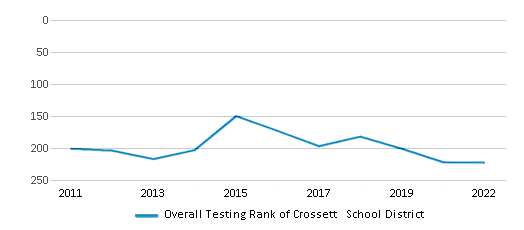
Math Test Scores (% Proficient)
20%
38%
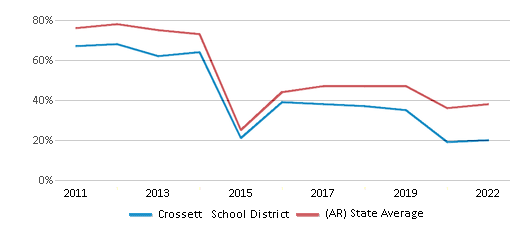
Reading/Language Arts Test Scores (% Proficient)
23%
40%
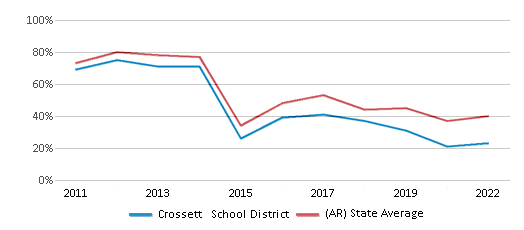
Science Test Scores (% Proficient)
20%
36%
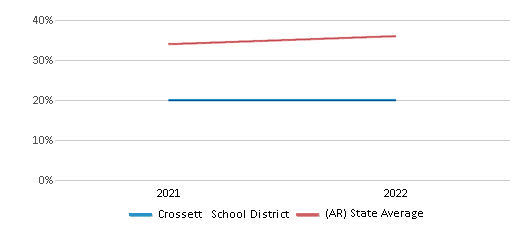
Graduation Rate
80-84%
88%
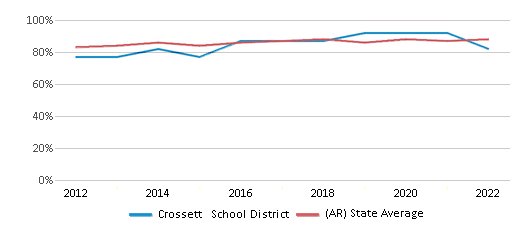
Students by Ethnicity:
Diversity Score
0.53
0.60
# American Indian Students
5 Students
846 Students
% American Indian Students
n/a
1%
# Asian Students
4 Students
2,865 Students
% Asian Students
n/a
2%
# Hispanic Students
49 Students
21,477 Students
% Hispanic Students
3%
14%
# Black Students
549 Students
28,045 Students
% Black Students
34%
19%
# White Students
971 Students
87,000 Students
% White Students
60%
59%
# Hawaiian Students
n/a
1,533 Students
% Hawaiian Students
n/a
1%
# Two or more races Students
51 Students
5,775 Students
% of Two or more races Students
3%
4%
Students by Grade:
# Students in PK Grade:
118
20
# Students in K Grade:
110
725
# Students in 1st Grade:
130
806
# Students in 2nd Grade:
120
836
# Students in 3rd Grade:
117
826
# Students in 4th Grade:
107
1,120
# Students in 5th Grade:
110
4,995
# Students in 6th Grade:
105
20,844
# Students in 7th Grade:
126
36,641
# Students in 8th Grade:
103
37,270
# Students in 9th Grade:
157
18,603
# Students in 10th Grade:
123
8,958
# Students in 11th Grade:
114
8,347
# Students in 12th Grade:
89
7,514
# Ungraded Students:
-
36
District Revenue and Spending
The revenue/student of $13,495 is higher than the state median of $13,132. The school district revenue/student has stayed relatively flat over four school years.
The school district's spending/student of $12,010 is less than the state median of $13,043. The school district spending/student has stayed relatively flat over four school years.
Total Revenue
$22 MM
$6,371 MM
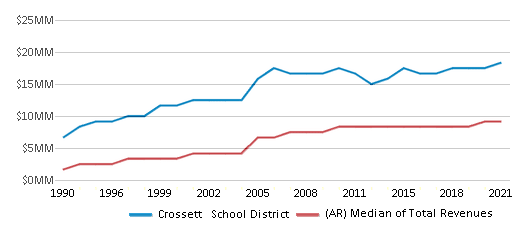
Spending
$20 MM
$6,327 MM
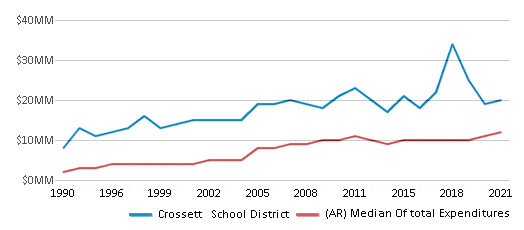
Revenue / Student
$13,495
$13,132

Spending / Student
$12,010
$13,043
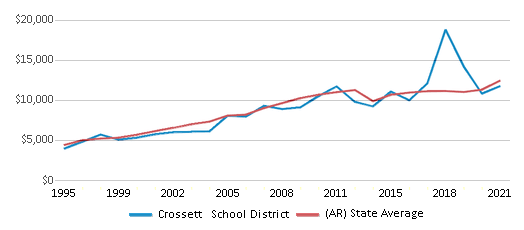
Best Crossett School District Public Middle Schools (2025)
School
(Math and Reading Proficiency)
(Math and Reading Proficiency)
Location
Grades
Students
Rank: #11.
Crossett Middle School
(Math: 20% | Reading: 24%)
Rank:
Rank:
2/
Bottom 50%10
100 Petersburg Rd
Crossett, AR 71635
(870) 364-4712
Crossett, AR 71635
(870) 364-4712
Grades: 5-8
| 444 students
Recent Articles

Year-Round Or Traditional Schedule?
Which is more appropriate for your child? A year-round attendance schedule or traditional schedule? We look at the pros and cons.

Why You Should Encourage Your Child to Join a Sports Team
Participating in team sports has a great many benefits for children, there is no doubt. In this article you will learn what those benefits are.

White Students are Now the Minority in U.S. Public Schools
Increasing birth rates among immigrant families from Asia and Central and South America, combined with lower birth rates among white families, means that for the first time in history, public school students in the United States are majority-minority. This shift in demographics poses difficulties for schools as they work to accommodate children of varying language abilities and socio-economic backgrounds.





